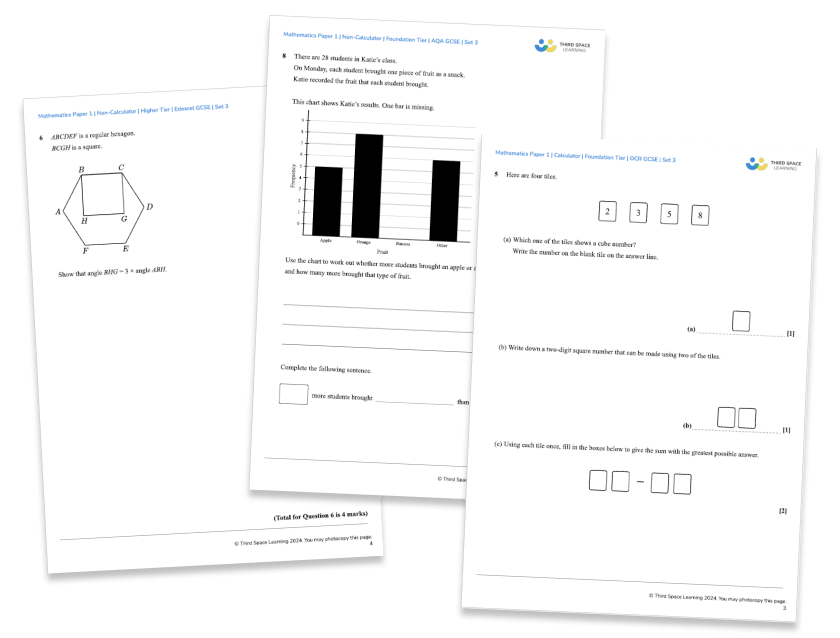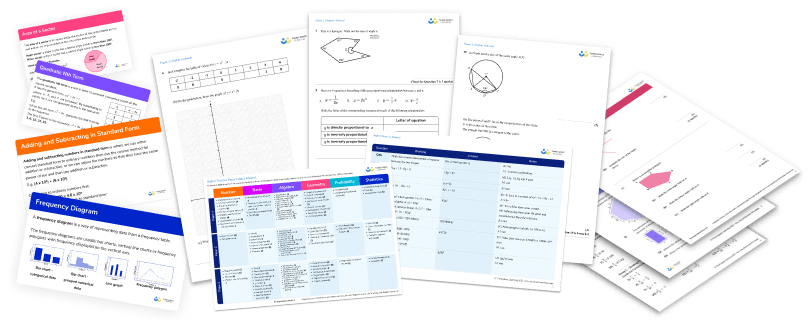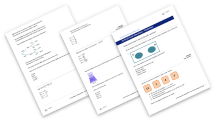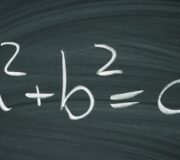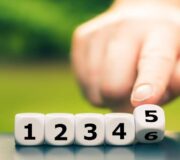25 GCSE Maths Questions And Answers By Topic And Difficulty
Preparing for GCSE maths questions means more than memorising formulas—it requires fluency with the full range of question types students face in their exams. From algebra to probability, each topic demands not just knowledge but the ability to apply it under exam conditions.
That’s where targeted practice makes all the difference. Below you’ll find 25 GCSE maths questions written in the style of real AQA, OCR, and Edexcel exam papers. Each one is designed to test understanding, expose common misconceptions, and build confidence through repeated practice.
Whether you’re running revision sessions, intervention sessions, or setting homework, these questions, complete with worked answers and a free downloadable worksheet, give you a practical tool for building exam readiness and tracking progress.
If you’re short on time, you can download all 25 GCSE maths questions and answers here:
Set of 25 Printable GCSE Maths Questions
Try these challenging GCSE maths questions with your students in class. They all include answers on a separate page and are organised by difficulty!
Download Free Now!Challenge level of these GCSE maths questions
GCSE papers need to be accessible to students with a wide range of knowledge and skills. This enables the exam boards to produce a distribution of results in order to calculate appropriate GCSE grade boundaries. Therefore, every exam paper has questions which can present challenges to every student.
Elements that can increase the difficulty of the question include:
- the language within each question,
- presenting a topic in an unfamiliar context,
- limited structure and guidance,
- interleaving of skills.
In the following GCSE exam questions, you will find questions for a range of key GCSE maths topics from Grade 9 to Grade 4 foundation maths. The level of difficulty for each GCSE maths question is determined by:
- the complexity of the question,
- common errors students are likely to make on a question,
- how many students are likely to be able to access the question,
- my own experience preparing students for GCSE maths exams for many years.
LOOKING FOR MORE GCSE MATHS EXAM QUESTIONS BY TOPIC?
If you’re looking for more GCSE maths questions by topic, you can download pdfs with answers for hundreds of Exam Questions in the GCSE maths revision section of this website. All geometry, algebra, number, ratio and proportion, probability and statistics topics covered.
This is the range of GCSE maths questions you can expect in this article:
- Grade 8 and 9 GCSE questions
- Hard GCSE maths questions
- GCSE higher maths paper questions
- Grade 4 and 5 GCSE maths questions
- Topics to focus your GCSE maths revision on
For students who need extra maths support, schools can implement AI maths tutoring with Skye to practice GCSE maths questions at a pace that suits them. Skye provides dialogue-driven online one to one GCSE maths tutoring for students aiming for grades 3-7. The flexible nature of AI tutoring means students can log on to sessions during regular, timetabled slots or on demand to suit their revision needs. Each lesson uses revision techniques and exam-style questions that scaffold learning and guide students towards independent practice and build confidence.
Find out how schools like yours are making the most out of AI tutoring and AI in education.
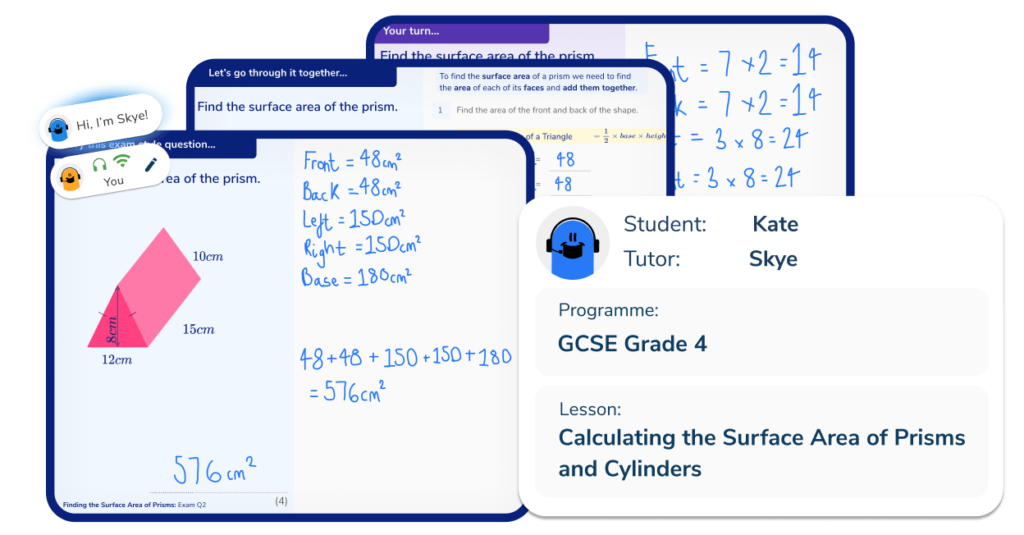
Grade 8 and Grade 9 style GCSE maths questions
These GCSE questions require a secure set of mathematical skills and accuracy in applying them. The questions may look simple in their presentation, but they require students to carefully select and apply the key skills. These skills are often revisited as an introduction to an A Level maths course.
1. Factorising maths question
(a) Factorise d^{2} – e^{2}
(b) Hence, or otherwise, simplify fully
(x^{2} + 8)^{2} – (x^{2} – 4)^{2}
Which is the correct answer?
A) (x + 8)(x – 4)
B) x^{2} + 12
C) x^{2} + 4
D) 24x^{2} + 48
Calculator
Answers
(a) (d+e)(d-e)
(1 mark)
(b) D) 24x^{2} + 48
(3 marks)
Answer explanation
For b) students may not use the difference of two squares as they did in part a) and proceed to try and expand then simplify the brackets. While this is a correct method, it is a longer process and is therefore subject to potential errors. To spot the more efficient method of the difference of two squares, students first have to recognise part b) is in the same form as part a) and that it can be rewritten in the form (x2 + 8 − x2 + 4)(x2 + 8 + x2 − 4).
Next, the algebra needs to be simplified with extra care needed to ensure that the negative and positive signs are correct. Finally, the student needs to decide how to present the fully simplified answer.
For more GCSE maths questions, take a look at our free Factorising lessons.
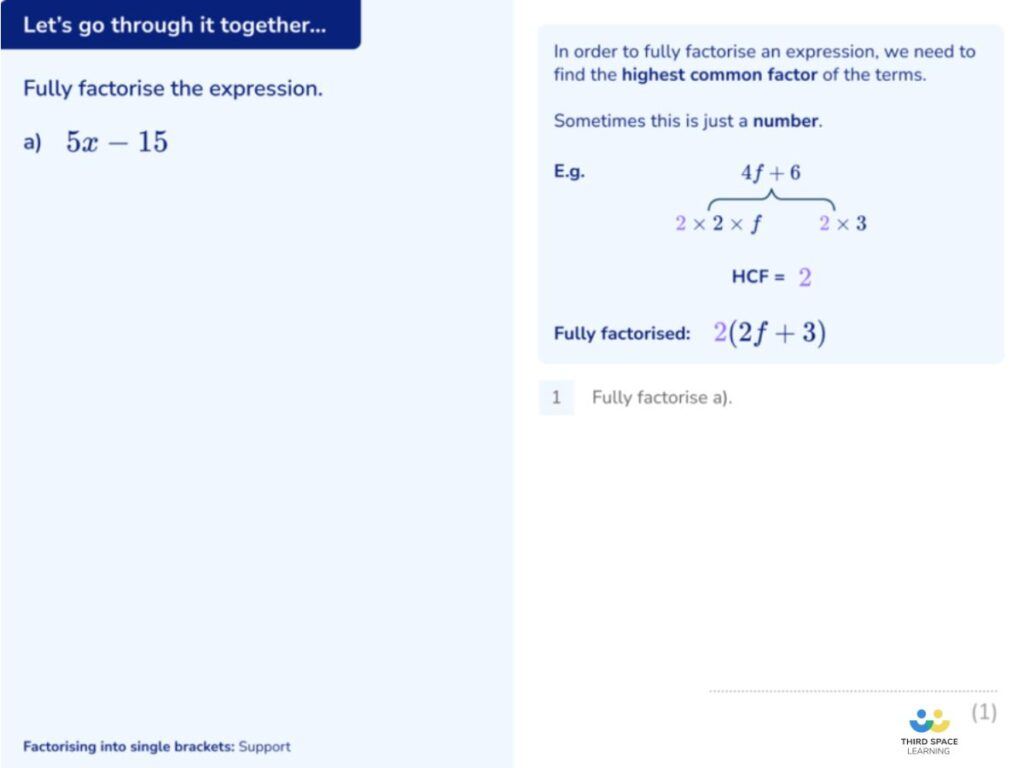
2. Surds maths question
Show that \frac{2\sqrt{14}}{\sqrt{5}}-\frac{\sqrt{7}}{\sqrt{10}} can be written in the form \frac{a\sqrt{b}}{10}
Where a and b are integers.
Which is the correct answer?
A) \frac{3\sqrt{7}}{10}
B) \frac{3\sqrt{70}}{10}
C) \frac{2\sqrt{7}}{10}
D) \frac{\sqrt{7}}{\sqrt{10}}
Non-calculator
Answer
B) \frac{3\sqrt{70}}{10}
(3 marks)
Answer explanation
This question requires confidence with subtracting fractions and manipulating surds. There are various methods to completing this question, but the easiest way is to multiply the numerator and denominator of the first fraction by √2 so that both fractions have a common denominator of √10. This can present difficulties as the numerator could be multiplied by 2 rather than √2. Students then need to recognise that once both fractions have common denominators, they can simply subtract the surds on the numerator.
Finally, they need to rationalise the denominator by multiplying the numerator and denominator by √10 and simplifying.
For more GCSE maths questions, take a look at our free Surds lessons.
3. Algebraic fractions maths question
2-\frac{x+2}{x-3}-\frac{2 x-5}{x+3} can be written as a single fraction in the form \frac{ax^{2}+b x+c}{x^{2}-9}
Where a and b are integers.
Work out the value of a and the value of b and c .
Calculator
Answer
=\frac{2(x-3)(x+3)-(x+2)(x+3)-(2 x-5)(x-3)}{(x+3)(x-3)}
(1 mark)
=\frac{2\left(x^2-9\right)-\left(x^2+5 x+6\right)-\left(2 x^2-6 x-5 x+15\right)}{x^2-9}
=\frac{2 x^2-18-x^2-5 x-6-2 x^2+11 x-15}{x^2-9}
(1 mark)
=\frac{-x^2+6 x-39}{x^2-9}
(1 mark)
a=-1, b=6, c=-39
(1 mark)
Answer explanation
Students need to be confident with a variety of skills including order of operations, subtracting fractions and integers, expanding brackets and simplifying. There are a variety of mistakes that can be made when expanding brackets and simplifying the fractions. It is important to consider the effect of negative signs when subtracting brackets.
For more GCSE maths questions, take a look at our free Algebraic fractions lessons.
Hard GCSE maths questions
The following GCSE maths questions have been selected to highlight the more unusual way they are presented. This can lead to assumptions being made about the question, which may lead to an incorrect approach.
4. Quadratic graphs maths questions
The diagram shows part of the graph y = x^{2} – 3x + 4 .
(a) By drawing a suitable line, use your graph to find estimates for the solutions of x^{2} – 2x -1 = 0 .
P is a point of the graph y = x^{2} – 3x + 4 where x = 4 .
(b) Calculate an estimate for the gradient of the graph at the point P .
Answers
(a) x = 2.4, -0.4
(2 marks)
(b) Answers around 4
(3 marks)
Answer explanation
Students may try to solve the equation by attempting to factorise or use the quadratic formula. However, as the question states, to use the graph, students need to compare the equation of the graph with the equation given in a) and identify what has changed. They need to identify that the x value has decreased by 1 and the constant value has increased by 5. Therefore, they need to accurately plot the line y = − x + 5 on the graph. Finally, they need to remember that the two solutions are found at the two intersection points.
Part b) is a more challenging question as they need to find appropriate points either side of the point P to calculate the gradient.
For more GCSE maths questions, take a look at our free Quadratic graphs lessons.
5. Nth term maths question
The n th of a sequence is given by an^{2} + bn where a and b are integers.
The 3rd term of the sequence is 3 .
The 6th term of the sequence is 42 .
Find the 5th term of the sequence.
Which is the correct answer?
A) 29
B) 5
C) 25
D) 18
Answer
C) 25
(4 marks)
Answer explanation
Students need to construct the two equations by substituting n = 3 and n = 6 in an2 + bn in order to produce a pair of simultaneous equations which can then be solved. After calculating the values of a and b, students need to remember to finish the question by substituting ‘5’ into the nth term.
For more GCSE maths questions, take a look at our free Nth term lessons.
6. Algebraic fractions maths question
Solve \frac{4x+1}{4}-\frac{2x+1}{3}=\frac{1-x}{6}
Which is the correct answer?
A) x = 0.5
B) x = -0.5
C) x = – 5
D) x = 12
Calculator
Answer
A) x = 0.5
(4 marks)
Answer explanation
Fractions can present difficulties for both higher and foundation students. As this question gives two fractions subtracting to give a third, students may attempt to find a common denominator for all three fractions in the first step. When subtracting the fractions, students must take care to insert brackets and/or multiply every term. E.g. if 4x + 1 is multiplied by 3, this should be 3(4x + 1) or 12x + 3.
A common mistake would be to not multiply the term that is outside the bracket by every term inside the bracket.
For more GCSE maths questions, take a look at our free Algebraic fractions lessons.
GCSE higher maths questions
These GCSE maths questions appear on the higher tier paper and draw on a range of skills. They often lack structure and hints, and require the student to confidently work out what is required to work out the solution.
7. Venn diagram maths question
60 people were asked if they spoke French, German or Italian.
Of these people,
- 21 speak French
- 1 speaks French, German and Italian
- 4 speak French and Italian but not German
- 7 speak German and Italian
- 18 do not speak any of the languages
- All 11 people who speak German speak at least one other language.
Two of the 60 people are chosen at random. Work out the probability that they both only speak French.
Which is the correct answer?
A) \frac{12}{60}
B) \frac{13}{295}
C) \frac{1}{25}
D) \frac{11}{295}
Calculator
Answer
D) \frac{11}{295}
(5 marks)
Answer explanation
Students need to recognise that this question requires a 3-way Venn diagram as it could easily be mistaken for a two-way table question. Extracting the correct meaning from the language used in the question can present a challenge in order to place the numbers correctly in the diagram or calculate missing values.
To answer the final question, they need to correctly identify the probability that the person speaks only French and multiply these probabilities.
For more GCSE maths questions, take a look at our free Venn diagram lessons and Venn diagram questions.
8. Quadratic equations maths question
In the diagram, the square and the trapezium share a common side length of x cm.
The area of the square is equal to the area of the trapezium.
Work out the value of x .
Which is the correct answer?
A) 12 cm
B) 6 cm
C) 64 cm
D) 8 cm
Calculator
Answer
A) 12 cm
(6 marks)
Answer explanation
Students often find forming equations difficult. After recognising that they need to form a quadratic equation, they need to apply the formula for the area of a trapezium (one which students often struggle to recall). Once they have successfully constructed the correct equation, they then need to rearrange it to make the equation equal to 0 and then factorise.
A common mistake that is made when students see terms on each side of the equals sign, is that they attempt to solve as though it is a linear equation. Once the equations have been correctly solved, they need to interpret their solutions by only selecting the positive result. This is because it is impossible to have a negative distance for a side length.
For more GCSE maths questions, take a look at our free Quadratic equations lessons.
9. Area of a circle maths question
A square with sides of length x mm, is inside a circle.
Each vertex of the square is on the circumference of the circle.
The area of the circle is 64 mm ^{2} .
Work out the value of x .
Give your answer correct to 3 significant figures.
Which is the correct answer?
A) 4.51 mm
B) 20.35 mm
C) 6.38 mm
D) 40.74 mm
Calculator
Answer
C) 6.38 mm
(4 marks)
Answer explanation
The first challenge with this question is the absence of a diagram. Students need to interpret the question correctly and create their own diagram. Students need to recall the formula for area of a circle and rearrange it to calculate the radius, which is also the distance from the centre of the square to one of its vertices.
Students are required to know that the diagonal lines within a square are perpendicular and therefore need to apply Pythagoras’ theorem to calculate the side length of the square. Finally, it is important they correctly round their answer to 3 significant figures.
For more GCSE maths questions, take a look at our free Area of a circle lessons.
10. Rearranging formulae maths question
Make b the subject of the formula c=\frac{25(a-3b)}{b}
Which is the correct answer?
A) b=\frac{cb-25a}{3}
B) b=\frac{25a}{c+75}
C) b=\frac{a}{c+75}
D) b=\frac{c b-25 a}{-75}
Calculator
Answer
B) b=\frac{25a}{c+75}
(3 marks)
Answer explanation
A rearranging question where the subject appears twice will be accessible to more able students. However, this question has some unfamiliar elements compared to the usual rearranging questions, which require factorising, due to the placement of the brackets and b appearing on its own as the denominator.
For more GCSE maths questions, take a look at our free Rearranging formulae lessons.
11. Tree diagrams maths question
David has two spinners, spinner A and spinner B.
Each spinner can only land on blue or green.
The probability that spinner A will land on blue is 0.25.
The probability that spinner B will land on green is 0.8.
The probability tree diagram shows this information.
David spins spinner A and spinner B together.
He does this a number of times.
The number of times both spinners land on blue is 40.
Work out an estimate for the numbers of times both spinners land on green.
Which is the correct answer?
A) 800
B) 64
C) 128
D) 480
Calculator
Answer
D) 480
(3 marks)
Answer explanation
Tree diagram questions can be straightforward for students to identify what to do, but this question has a twist as students need to understand the calculation within a tree diagram in order to work backwards and calculate how many times the spinner was spun. Relative frequency is disguised in this question rather than a typical part a) complete the tree diagram part b) calculate the probability.
For more GCSE maths questions, take a look at our free Tree diagrams lessons.
12. Circle theorems maths question
W , X , Y and Z are four points on the circumference of a circle.
WCY and XCZ are straight lines.
Prove that triangle CWX and triangle CYZ are similar.
You must give reasons for each stage of your working.
Calculator
Answer
Angle WXC = Angle CYZ because angles in the same segment are equal.
Angle XWC = Angle CZY because angles in the same segment are equal.
Angle WCX = Angle ZCY because vertically opposite angles are equal.
(We only need two of these angles as we can calculate the third by using the fact that angles in a triangle add to 180 degrees.)
(3 marks)
Answer explanation
Students need to identify the word ‘similar’ and understand its significance in this question. Students often struggle with ‘prove’ type questions, and it is common for them to be unsure how to set out their working. Ensuring students are confident with angle notation and how to recall the circle theorems is essential.
Modelling how this style of question should be set out using very logical steps, with angles and reasons side by side, can be beneficial.
For more GCSE maths questions, take a look at our free Circle theorems lessons.
13. Direct and inverse proportion maths question
y is inversely proportional to t^{2}
When t = 3 , y = 4 .
t is directly proportional to x^{2}
When x = 2 , t = 8 .
Find a formula for y in terms of x .
Give your answer in its simplest form.
Which is the correct answer?
A) y=\frac{9}{x^{2}}
B) y=\frac{9}{x^{4}}
C) y=\frac{18}{x^{2}}
D) y=\frac{18}{x^{4}}
Non-calculator
Answer
B) y=\frac{9}{x^{4}}
(5 marks)
Answer explanation
Students must be confident with finding the value of the constant for each equation and apply the powers. They need to recognise how to substitute the second equation into the first, taking care to make it ‘t =’ and not ‘y =’, then simplify the fraction.
For more GCSE maths questions, take a look at our free Direct and inverse proportion lessons.
14. Standard form maths question
Use the formula F=\frac{s}{\sqrt{tm}} to find the value of F when
s = 6.2 × 10^{9}
t = 4.3 × 10^{8}
m = 3.6 × 10^{-3}
Give your answer in standard form, correct to 2 significant figures.
Which is the correct answer?
A) 5.0 × 10^{6}
B) 4.9 × 10^{2}
C) 4.0 × 10^{4}
D) 4.9 × 10^{4}
Calculator
Answer
A) 5.0 × 10^{6}
(3 marks)
Answer explanation
This is a calculator paper question, so if students are confident with efficient use of their scientific calculator and correctly insert brackets where they are needed, they can enter the calculation to work it out. However, this is often subject to errors and if they work through the calculation in stages, they need to consider the order of operations and understand the effect of square rooting on the powers.
For more GCSE maths questions, take a look at our free Standard form lessons.
15. Histograms maths question
The histogram shows information about the weights of some letters handled by a delivery company in one week.
Sam says:
“There are more letters weighing between 20 g and 60 g than letters weighing between 60 g and 100 g.”
Is Sam correct?
Show how you decide.
Calculator
Answer
Sam is wrong.
Number of letters between 20 g and 60 g = 20 × 17.5 + 20 × 30 = 950
Number of letters between 60 g and 100 g = 30 × 20 + 10 × 40 = 1000
(4 marks)
Answer explanation
Students need to understand that the height of the bars is frequency density. Therefore, they need to calculate the area of the bars to calculate the frequencies and then compare the values. Once frequency has been calculated, these sorts of questions can then relate to other frequency-related question types, such as averages from a frequency table and cumulative frequency.
For more GCSE maths questions, take a look at our free Histograms lessons.
16. Straight line graphs maths question
A straight line graph goes through points
( a , b ) and ( c , d ), where
a + 3 = c
b + 6 = d
Find the gradient of the line.
Which is the correct answer?
A) 2
B) 3
C) 6
D) ½
Non-calculator
Answer
A) 2
(3 marks)
Answer explanation
Students need to know how to calculate the gradient between two coordinate points and then correctly identify the x and y coordinates. This question can easily become overly complicated, but with some simple rearranging to find d – b = 6 and c – a = 3, it is possible to calculate the gradient in a few steps. With four unknowns, students could easily become confused and think that the gradient is given as a formula.
However, it may also be that students can guess the answer to this question. Other question types could involve calculating the midpoint of two coordinates, or working out the equation of the straight line that passes through them, or is parallel or perpendicular to them.
For more GCSE maths questions, take a look at our free Straight line graphs lessons.
Grade 4 and Grade 5 style GCSE maths questions
The following GCSE maths questions are all questions that appear on both the higher and foundation paper, so are targeted at Grade 4 and Grade 5 students. Questions that solely appear on the foundation paper have not been selected as they tend to have simpler underlying structures or provide structure.
Read more: Question Level Analysis Of Edexcel Maths Past Papers (Foundation)
17. Pythagoras’ theorem maths question
This rectangular frame is made from 5 straight pieces of wood.
The weight of the wood is 2.5 kg per metre.
Work out the total weight of the wood in the frame.
Which is the correct answer?
A) 5 kg
B) 17.5 kg
C) 19 kg
D) 47.5 kg
Non-calculator
Answer
D) 47.5 kg
(5 marks)
Answer explanation
The numbers and calculations required for this question are straightforward. However, as it is a non-calculator paper, it presents some extra challenges. Students must identify that use of Pythagoras’ theorem is required, which can be unexpected on a non-calculator paper, despite the use of Pythagorean triples here. This question uses multiple skills including Pythagoras’ theorem, perimeter and multiplying decimals.
For more GCSE maths questions, take a look at our free Pythagoras theorem lessons.
18. Parallel lines maths question
The equation of the line L_{1} is y = 5x – 1 .
The equation of the line L_{2} is 5y – 25x + 4 = 0 .
Show that these two lines are parallel.
Non-calculator
Answer
Rearrange L_{2} to make y the subject.
\begin{aligned} 5 y-25 x+4 &=0 \\ 5 y &=25 x-4 \\ y &=5x-\frac{4}{5} \end{aligned}L_{1} and L _{2} have the same gradient so they are parallel.
(2 marks)
Answer explanation
Students may make a mistake in thinking that the x coefficient always indicates the gradient and when given two equations, if these coefficients are equal, then the lines are parallel. In this question, the fact that the first equation has ‘5x’ term and the second has ‘5y’ term could be mistaken as an indication that the two lines have the same gradient.
The second equation requires rearranging and dividing the whole equation by 5, which presents a fraction for the y-intercept value.
For more GCSE maths questions, take a look at our free Parallel lines lessons.
19. Lowest common multiple and highest common factor maths questions
(a) Find the lowest common multiple (LCM) of
30 and 54.
Which is the correct answer?
A) 270
B) 1620
C) 6
D) 540
(b) Write down the highest common factor (HCF) of
A and B .
Which is the correct answer?
A) 60
B) 54000
C) 900
D) 120
Calculator,
Answers
(a) A) 270
(2 marks)
(b) A) 60
(1 mark)you
Answer explanation
Students will often try to list multiples of each number until they find a common multiple. This can be a laborious process and is therefore subject to arithmetic errors. The most efficient method is to write each number as a product of its prime factors.
For more GCSE maths questions, look at our free Lowest common multiple and Highest common factor lessons.
20. Venn diagrams maths question
This diagram represents students in a year group who study Geography (G) or History (H).
How many students study both Geography and History?
Which is the correct answer?
A) Not enough information to tell
B) All of them
C) None of them
D) Half of them
Non-calculator
Answer
C) None of them
(1 mark)
Answer explanation
This style of question can be unfamiliar to students as Venn diagrams are almost always presented as overlapping circles. Students may not recognise this as a Venn diagram, and therefore may be unlikely to identify that the sets are independent of each other and share no data.
For more GCSE maths questions, look at our free Venn diagrams lessons.
21. Solving equations maths question
Work out the value of b .
Which is the correct answer?
A) 1
B) 5
C) 2
D) 25
Non-calculator
Answer
A) 1
(2 marks)
Answer explanation
Students need to be confident using square numbers, cube numbers and how to correctly apply square and cube roots. The question can appear to be challenging upon first inspection, but once the powers and roots have been simplified, it is an easy question to solve.
For more GCSE maths questions, look at our free Solving equations lessons.
22. Trigonometry maths question
XYZ is a right-angled triangle.
XZ = 15 cm.
Angle Z = 90° .
Size of angle ZYX : size of angle YXZ = 3:2 .
Work out the length of XY .
Give your answer correct to 3 significant figures.
Which is the correct answer?
A) 18.5 cm
B) 12.1 cm
C) 14.5 cm
D) 25.5 cm
Calculator
Answer
A) 18.5 cm
(4 marks)
Answer explanation
With the absence of angles YXZ and XYZ on the diagram, students need to firstly identify this as a trigonometry question and calculate the missing angles using the ratio. This then allows them to decide which trigonometric function to use. Finally, students need to correctly round their answer to 3 significant figures.
Higher graded questions on trigonometry can include using the Sine Rule, the Cosine Rule and calculating the area of any triangle using the formula ½abSinC.
For more GCSE maths questions, take a look at our free Trigonometry lessons.
23. Order of operations (BIDMAS) maths question
Sam is using these numbers to make a new number.
He can only use brackets, +, −, ×, ÷ once.
He cannot use any number more than once.
He cannot use powers.
He cannot put numbers together
e.g. he cannot use ‘147’.
What is the biggest number he can make?
Show how he can make this number.
Which is the correct answer?
A) 144
B) 132
C) 336
D) 51
Calculator
Answer
B) 132
(2 marks)
Answer explanation
There are multiple aspects to this question that need to be interpreted. and it requires a good understanding of the order of operations and place value. This must then be communicated clearly to obtain full marks. It could be assumed that multiplying all the numbers will find the largest result but the presence of the number ‘1’ is what alters this and requires the application of the order of operations.
For more GCSE maths questions, take a look at our free Order of operations (BIDMAS) lessons.
24. Formulae maths question
A puma is running with a velocity of 2 m/s.
It then accelerates at 3 m/s ^{2} for 5 seconds.
Use the formula
v = u + atto work out the final velocity of the puma.
Which is the correct answer?
A) 13 m/s
B) 17 m/s
C) 11 m/s
D) 10 m/s
Answer
B) 17 m/s
(2 marks)
Answer explanation
The first challenge is that students have to identify the values of u, a and t from the information, and this requires an understanding of the formula and velocity. Compound measures such as speed and density are often covered at foundation GCSE, but rarely expressed as acceleration and velocity.
For more GCSE maths questions, take a look at our free Formulae lessons.
See also: GCSE maths formulas
25. Density maths question
The density of orange juice is 1.02 grams per cm ^{3} .
The density of fruit syrup is 1.5 grams per cm ^{3} .
The density of lemonade is 0.95 grams per cm ^{3} .
30 cm ^{3} of orange juice is mixed with 20 cm ^{3} of fruit syrup and 150 cm ^{3} of lemonade to make a drink.
Work out the density of the drink.
Give your answer correct to 2 decimal places.
Which is the correct answer?
A) 3.47 g/cm ^{3}
B) 203.1 g/cm ^{3}
C) 1.02 g/cm ^{3}
D) 0.98 g/cm ^{3}
Calculator
Answer
C) 1.02 g/cm ^{3}
(4 marks)
Answer explanation
At a glance, this looks simple as students may think that they just need to total the densities of each part. However, they need to work out the mass of each part in order to calculate the total mass and total volume of the drink before calculating the total density. It is important to set out the calculations clearly.
Organising the information as a two-way table is an effective way of simplifying the problem. Students need to correctly round their solution to 2 decimal places.
For more GCSE maths questions, take a look at our free frequency density lessons.
The GCSE maths topics are:
• Number including fractions, decimals and percentages
• Algebra including equations, nth term etc.
• Geometry and measure including trigonometry
• Ratio and proportion including exchange rates
• Probability including frequency
• Statistics including pie chart
No, GCSE maths is not difficult if you are sitting the right exam and you have prepared. There are two GCSE exams – the foundation paper and the higher paper. The higher paper is more difficult. GCSE maths papers need to be accessible to students with a wide range of abilities. Therefore, every exam paper will have questions that can present difficulties to students.
The main elements that can increase the difficulty of a question include:
• The language of the question
• Presenting a topic in an unfamiliar context
• Limited structure and guidance
• Interleaving of skills
To help overcome initial difficulties, it is useful to be aware of these different elements when you first approach a GCSE question. Try to overlook your first concerns and identify the question they are asking you.
To answer a GCSE maths question the first thing you need to do is read the question properly. It is so important to take your time and really make sure you understand the intention behind the question. It is easy to get caught up in the language of the question and lose sight of what it is actually asking! So, take your time, and make sure you understand what the question is asking before putting the maths into practice.
A great way to practice GCSE maths is by using a range of different resources, such as practice questions, summary worksheets and quick quizzes. You want to find resources that are both engaging and effective, getting you to familiarise yourself with the material and layout of a GCSE Maths question. Third Space Learning has a growing resource library of GCSE Maths lessons and GCSE maths revision support created by maths experts to help prepare for maths GCSE. Take a look, see what works for you and get practising!
Focus your GCSE revision this year
Students need to be secure with some essential skills in order to access the sorts of GCSE maths questions that have been included above. Focus on these to start with:
| Higher | Foundation |
| – Surds – Fraction operations – Factorising – Rounding to significant figures | – Recall formulae – Solving equations – Substitution – Square and cube numbers and roots – Rounding to decimal places and significant figures |
GCSE MATHS 2026: STAY UP TO DATE
Join our email list to stay up to date with the latest news, revision lists and resources for GCSE maths 2026. We’re analysing each paper during the course of the 2026 GCSEs in order to identify the key topic areas to focus on for your revision.
GCSE dates 2026
GCSE results (2026 when available)
Get ahead on revision with the GCSE maths papers analysis from 2025:
Analysis of GCSE Maths Paper 1 2025
Analysis of GCSE Maths Paper 2 2025
GCSE Maths Paper Analysis and Summary 2025
GCSE Maths Teacher Survey Results 2025
DO YOU HAVE STUDENTS WHO NEED MORE SUPPORT IN MATHS?
Skye – our AI maths tutor built by teachers – gives students personalised one-to-one lessons that address learning gaps and build confidence.
Since 2013 we’ve taught over 2 million hours of maths lessons to more than 170,000 students to help them become fluent, able mathematicians.
Explore our AI maths tutoring or find out how our GCSE maths tutoring programmes could support students in your school.
